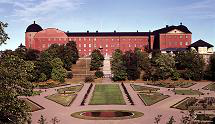Speaker
Ms
Pauline Comini
(CEA Saclay IRFU/SPP)
Description
The GBAR experiment (Gravitational Behaviour of Antihydrogen at Rest) [1,2] was recently accepted at CERN at its Antiproton Decelerator facility. The aim of the experiment is to perform the free fall of antihydrogen atoms (Hbar) to test the weak equivalence principle for antimatter. In order to reduce the uncertainty on the initial Hbar velocity, ultra-cold antihydrogen atoms of a few neV are required. The key idea of the GBAR experiment is to use Hbar+ ions that can be cooled with techniques established for ultra-cold atoms [see talk by Paul Indelicato at this conference]. The Hbar+ ions will be produced from collisions between keV antiprotons (pbar) and a positronium (Ps) cloud through two successive reactions:
(1) pbar + Ps(n_p,l_p) -> Hbar(n_h,l_h) + e- (3-body reaction)
(2) Hbar(n_h,l_h ) + Ps(n_p,l_p) -> Hbar+ + e- (4-body reaction).
A theoretical study of reactions (1) & (2) has been undertaken in order to optimise the Hbar+ production by choosing accurately the energy of the pbar beam and the Ps excited state (n_p,l_p).
An exhaustive set of cross sections has been obtained for both reactions, from Ps(1s) to Ps(3d) and considering Hbar states up to n_h=4. Contrary to reaction (2) [3,4], reaction (1) has been already widely studied, mainly through the reverse reaction of Ps formation (for instance in [5]), but for the sake of theoretical consistency, it has been decided to apply the same theoretical model, namely the Continuum Distorted Wave – Final State model (CDW-FS), to compute the cross sections of both reactions at the same level of approximation. [6] Concerning reaction (2), the highly correlated system formed by Hbar+ has been treated carefully, using three different wave functions proposed for H-. [7,8]
In the case of reaction (1), the results show an enhancement of the Hbar production toward low pbar kinetic energies, when n_h and n_p increase. This agrees with experimental data [9] and previous calculations [5]. For reaction (2), a nearly resonant behaviour close to threshold is observed for excited positronium, when Hbar is in its ground state. For both reactions, above 1 keV pbar energy, the highest cross sections are obtained with Ps(2p). In order to estimate the Hbar+ production in the reaction chamber of the GBAR experiment and optimise other experimental parameters such as laser power for Ps excitation and delays between pulses, a simulation based on the present cross sections, solving Bloch equations to compute the Ps populations, has been implemented. This highlights the challenges to be solved in this critical part of GBAR.
References
[1] The GBAR Collaboration 2011 CERN-SPSC-2011-029, SPSC-342
[2] P. Debu, Hyperfine Interact., 212, 51 (2012).
[3] M. T. McAlinden et al., Phys. Rev. A 65, 032711 (2002).
[4] S. Roy and C. Sinha, Eur. Phys. J. D 47, 327 (2008).
[5] J. Mitroy, Phys. Rev. A 52, 2859 (1995).
[6] J. Hanssen et al., Phys. Rev. A 63, 012705 (2001).
[7] S. Chandrasekhar, Astrophys. J. 100, 176 (1944).
[8] C. Le Sech, J. Phys. B: At. Mol. Opt. Phys. 30, L47 (1997).
[9] J.P. Merrison et al., Phys. Rev. Lett. 78, 2728 (1997).
Primary author
Ms
Pauline Comini
(CEA Saclay IRFU/SPP)
Co-authors
Dr
François Biraben
(Laboratoire Kastler Brossel, Ecole Normale Supérieure, CNRS, Université P. et M. Curie)
Prof.
Paul-Antoine Hervieux
(Institut de Physique et Chimie des Matériaux de Strasbourg, CNRS and Université de Strasbourg)

